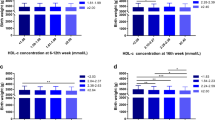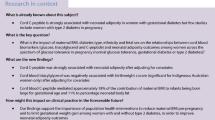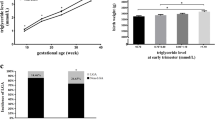Abstract
This study aimed to investigate the associations between cord serum total cholesterol (TC) and triglyceride (TG)levels and perinatal factors and determine the reference levels of cord blood TC and TG in Japanese neonates. This was a prospective birth cohort study using data from the Japan Environment and Children’s Study, which included data on births from 2011 to 2014 in Japan. TC and TG levels were determined in cord blood samples. A total of 70,535 pairs of neonates (male: 36,001, female: 34,524) and mothers were included. The mean cord blood TC and TG levels were 72.2 mg/dL and 24.4 mg/dL, respectively. Multiple regression analyses revealed that gestational age and birth weight were significantly associated with cord blood TC (coefficient −2.35, 95% confidence interval [CI] −2.40 – −2.22 and coefficient 0.002, 95% CI 0.002–0.003, respectively) and TG (coefficient 3.09, 95% CI 3.01–3.17 and coefficient − 0.009, 95% CI − 0.009–0.008, respectively) levels. Mean cord blood TG and TC levels decreased over the preterm period; however, these parameters increased during the term. Furthermore, the mean cord blood TC and TG levels decreased over the entire range of birth weight categories.
Conclusion: Mean cord blood TG and TC levels decreased over the preterm period; however, these parameters increased during the term. Furthermore, the mean cord blood TC and TG levels decreased over the entire range of birth weight categories in Japanese newborns. Maternal complications such as maternal parity, HDP, PROM, maternal obesity and income level were associated with cord TC and TG levels.
What is Known: • No studies have ascertained the reference levels of cord blood lipid levels in Japan. | |
What is New: • Mean cord blood TG and TC levels decreased over the preterm period; however, these parameters increased during the term. |



Similar content being viewed by others
Data availability statement
Data are unsuitable for public deposition due to ethical restrictions and legal framework of Japan. It is prohibited by the Act on the Protection of Personal Information (Act No. 57 of 30 May 2003, amendment on 9 September 2015) to publicly deposit the data containing personal information. Ethical Guidelines for Medical and Health Research Involving Human Subjects enforced by the Japan Ministry of Education, Culture, Sports, Science and Technology and the Ministry of Health, Labour and Welfare also restricts the open sharing of the epidemiologic data. All inquiries about access to data should be sent to: jecs-en@nies.go.jp. The person responsible for handling enquiries sent to this e-mail address is Dr Shoji F. Nakayama, JECS Programme Office, National Institute for Environmental Studies.
References
Crump C, Howell EA, Stroustrup A, McLaughlin MA, Sundquist J, Sundquist K (2019) Association of preterm birth with risk of ischemic heart disease in adulthood. JAMA Pediatr 173(8):736–743. https://doi.org/10.1001/jamapediatrics.2019.1327
Starnberg J, Norman M, Westrup B, Domellöf M, Berglund SK (2019) Cardiometabolic risk factors in children born with marginally low birth weight: A longitudinal cohort study up to 7 years-of-age. PLoS ONE 14(4):e0215866
Jin WY, Lin SL, Hou RL et al (2016) Associations between maternal lipid profile and pregnancy complications and perinatal outcomes: a population-based study from China. BMC Pregnancy Childbirth 16:60. https://doi.org/10.1186/s12884-016-0852-9
Misra VK, Trudeau S, Perni U (2011) Maternal serum lipids during pregnancy and infant birth weight: the influence of prepregnancy BMI. Obesity (Silver Spring) 19(7):1476–1481. https://doi.org/10.1038/oby.2011.43
Pires A, Sena C, Seiça R (2016) Dyslipidemia and cardiovascular changes in children. Curr Opin Cardiol 31(1):95–100. https://doi.org/10.1097/HCO.0000000000000249
Bastida S, Sánchez-Muniz FJ, Cuena R, Perea S, Aragonés A (2002) High density lipoprotein-cholesterol changes in children with high cholesterol levels at birth. Eur J Pediatr 161(2):94–98
Kallio MJ, Salmenperä L, Siimes MA, Perheentupa J, Miettinen TA (1993) Tracking of serum cholesterol and lipoprotein levels from the first year of life. Pediatrics 91(5):949–954
Akcakus M, Altunay L, Yikilmaz A, Yazici C, Koklu E (2010) The relationship between abdominal aortic intima-media thickness and lipid profile in neonates born to mothers with preeclampsia. J Pediatr Endocrinol Metab 23(11):1143–1149. https://doi.org/10.1515/jpem.2010.179
Yonezawa R, Okada T, Kitamura T et al (2009) Very low-density lipoprotein in the cord blood of preterm neonates. Metabolism 58(5):704–707. https://doi.org/10.1016/j.metabol.2009.02.004
Kelishadi R, Badiee Z, Adeli K (2007) Cord blood lipid profile and associated factors: baseline data of a birth cohort study. Paediatr Perinat Epidemiol 21(6):518–524. https://doi.org/10.1111/j.1365-3016.2007.00870.x
Gunes T, Koklu E, Ozturk MA (2007) Maternal and cord serum lipid profiles of preterm infants with respiratory distress syndrome. J Perinatol 27(7):415–421. https://doi.org/10.1038/sj.jp.7211775
Mocarzel CC, Velarde GC, Antunes RA, Moreira de Sá RA, Kurjak A (2020) Maternal obesity influences the endocrine cord blood profile of their offspring. J Perinat Med 48(3):242–248. https://doi.org/10.1515/jpm-2019-0387
Pac-Kożuchowska E, Rakuś-Kwiatosz A, Krawiec P (2018) Cord blood lipid profile in healthy newborns: A prospective single-center study. Adv Clin Exp Med 27(3):343–349. https://doi.org/10.17219/acem/65854
Bansal N, Cruickshank JK, McElduff P, Durrington PN (2005) Cord blood lipoproteins and prenatal influences. Curr Opin Lipidol 16(4):400–408. https://doi.org/10.1097/01.mol.0000174154.61307.16
Bhowmik B, Siddique T, Majumder A et al (2019) Maternal BMI and nutritional status in early pregnancy and its impact on neonatal outcomes at birth in Bangladesh. BMC Pregnancy Childbirth 19(1):413. https://doi.org/10.1186/s12884-019-2571-5
Brittos T, de Souza WB, Anschau F, Pellanda L (2016) Lipids and leukocytes in newborn umbilical vein blood, birth weight and maternal body mass index. J Dev Orig Health Dis 7(6):672–677. https://doi.org/10.1017/S2040174416000362
Kawamoto T, Nitta H, Murata K et al (2014) Rationale and study design of the Japan environment and children’s study (JECS). BMC Public Health 10(14):25
Itabashi K, Miura F, Uehara R, Nakamura Y (2014) New Japanese neonatal anthropometric charts for gestational age at birth. Pediatr Int 56(5):702–708
Sasaki H, Arata N, Tomotaki A et al (2020) Time course of metabolic status in pregnant women: The Japan Environment and Children’s Study. J Diabetes Investig 11(5):1318–1325
Crump C, Sundquist J, Sundquist K (2019) Association of preterm birth with lipid disorders in early adulthood: A Swedish cohort study. PLoS Med 16(10):e1002947. https://doi.org/10.1371/journal.pmed.1002947
Merzouk H, Madani S, Prost J, Loukidi B, Meghelli-Bouchenak M, Belleville J (1999) Changes in serum lipid and lipoprotein concentrations and compositions at birth and after 1 month of life in macrosomic infants of insulin-dependent diabetic mothers. Eur J Pediatr 158(9):750–756
Küster A, Croyal M, Moyon T, Darmaun D, Ouguerram K, Ferchaud-Roucher V (2022) Characterization of lipoproteins and associated lipidome in very preterm infants: a pilot study. Pediatr Res. https://doi.org/10.1038/s41390-022-02159-9
Napoli C, D'Armiento FP, Mancini FP et al (1997) Fatty streak formation occurs in human fetal aortas and is greatly enhanced by maternal hypercholesterolemia. Intimal accumulation of low-density lipoprotein and its oxidation precede monocyte recruitment into early atherosclerotic lesions. J Clin Invest 100(11):2680–2690. https://doi.org/10.1172/JCI119813
Gaillard R, Rurangirwa AA, Williams MA et al (2014) Maternal parity, fetal and childhood growth, and cardiometabolic risk factors. Hypertension 64(2):266–274. https://doi.org/10.1161/HYPERTENSIONAHA.114.03492
Katragadda T, Mahabala RS, Shetty S, Baliga S (2017) Comparison of cord blood lipid profile in preterm small for gestational age and appropriate for gestational age newborns. J Clin Diagn Res 11(1):SC05–SC07. https://doi.org/10.7860/JCDR/2017/24247.9197
Pecks U, Brieger M, Schiessl B et al (2012) Maternal and fetal cord blood lipids in intrauterine growth restriction. J Perinat Med 40(3):287–296
Bastida S, Sánchez-Muniz FJ, Cuesta C, Perea S, Aragonés A (1997) Male and female cord blood lipoprotein profile differences throughout the term-period. J Perinat Med 25(2):184–191. https://doi.org/10.1515/jpme.1997.25.2.184
Kharb S, Kaur R, Singh V, Sangwan K (2010) Birth weight, cord blood lipoprotein and apolipoprotein levels in Indian newborns. Int J Prev Med 1(1):29–33
Bastida S, Cuesta C, Perea S, Aragonés A, Sánchez-Muniz FJ (1996) Lipid and lipoprotein changes throughout the term-period in neonates from the Toledo Study. Rev Esp Fisiol 52(1):23–29
Diaz M, Leal C, Ramon y Cajal J et al (1989) Cord blood lipoprotein-cholesterol: relationship birth weight and gestational age of newborns. Metabolism 38(5):435–438
Parkinson JR, Hyde MJ, Gale C, Santhakumaran S, Modi N (2013) Preterm birth and the metabolic syndrome in adult life: a systematic review and meta-analysis. Pediatrics 131(4):e1240–e1263. https://doi.org/10.1542/peds.2012-2177
Crump C, Sundquist K, Sundquist J, Winkleby MA (2011) Gestational age at birth and mortality in young adult- hood. JAMA 306(11):1233–1240. https://doi.org/10.1001/jama.2011.1331
Song L, Wang N, Peng Y, Sun B, Cui W (2022) Placental lipid transport and content in response to maternal overweight and gestational diabetes mellitus in human term placenta. Nutr Metab Cardiovasc Dis 32(3):692–702
Kyozuka H, Yasuda S, Murata T, Fukuda T, Yamaguchi A, Kanno A, Sato A, Ogata Y, Hosoya M, Yasumura S, Hashimoto K, Nishigori H, Fujimori K, Japan Environment and Children’s Study (JECS) Group (2021) Adverse obstetric outcomes in early-diagnosed gestational diabetes mellitus: The Japan Environment and Children's Study. J Diabetes Investig 12(11):2071–2079
Kyozuka H, Murata T, Fukuda T, Yamaguchi A, Kanno A, Yasuda S, Suzuki D, Takahashi T, Go H, Maeda H, Sato A, Ogata Y, Shinoki K, Hosoya M, Yasumura S, Hashimoto K, Fujimori K, Nishigori H (2022) Association between preconception dietary inflammatory index and neurodevelopment of offspring at 3 years of age: The Japan Environment and Children’s Study. Nutrition 102:111708
Acknowledgements
The authors are grateful to all participants in the study.
Members of the JECS Group as of 2021
Michihiro Kamijima (principal investigator, Nagoya City University, Nagoya, Japan), Shin Yamazaki (National Institute for Environmental Studies, Tsukuba, Japan), Yukihiro Ohya (National Center for Child Health and Development, Tokyo, Japan), Reiko Kishi (Hokkaido University, Sapporo, Japan), Nobuo Yaegashi (Tohoku University, Sendai, Japan), Koichi Hashimoto (Fukushima Medical University, Fukushima, Japan), Chisato Mori (Chiba University, Chiba, Japan), Shuichi Ito (Yokohama City University, Yokohama, Japan), Zentaro Yamagata (University of Yamanashi, Chuo, Japan), Hidekuni Inadera (University of Toyama, Toyama, Japan), Takeo Nakayama (Kyoto University, Kyoto, Japan), Tomotaka Sobue (Osaka University, Suita, Japan), Masayuki Shima (Hyogo Medical University, Nishinomiya, Japan), Hiroshige Nakamura (Tottori University, Yonago, Japan), Narufumi Suganuma (Kochi University, Nankoku, Japan), Koichi Kusuhara (University of Occupational and Environmental Health, Kitakyushu, Japan), and Takahiko Katoh (Kumamoto University, Kumamoto, Japan).
Funding
This study was funded by the Ministry of the Environment, Japan. The findings and conclusions of this article are solely the responsibility of the authors and do not represent the official views of the Ministry.
Author information
Authors and Affiliations
Consortia
Contributions
H.G. conceptualized and designed the study, analyzed the data, and drafted the initial manuscript. K.H., M.H., S.Y., A.A., Y.K., T.M, H.M., K.O., K.S., Y.O., A.S., H.N., K. F., and the JECS Group reviewed the manuscript and gave critical advice. All authors approved the final manuscript as submitted and agree to be accountable for all aspects of the work.
Corresponding author
Ethics declarations
Ethics approval and consent to participate
The JECS protocol was reviewed and approved by the Ministry of the Environment’s Institutional Review Board on Epidemiological Studies (No. 100910001) and by the ethics committees of all participating institutions (National Center for Child Health and Development, National Institute for Environmental Studies, Hokkaido University, Sapporo Medical University, Asahikawa Medical University, Japanese Red Cross Hokkaido College of Nursing, Tohoku University, Fukushima Medical University, Chiba University, Yokohama City University, University of Yamanashi, Shinshu University, University of Toyama, Nagoya City University, Kyoto University, Doshisha University, Osaka University, Osaka Women’s and Children’s Hospital, Hyogo College of Medicine, Tottori University, Kochi University, University of Occupational and Environmental Health, Japan, Kyushu University, Kumamoto University, University of Miyazaki, and University of the Ryukyus). The JECS was conducted in accordance with the principles of the Declaration of Helsinki and other national regulations and guidelines. All methods of this study were carried.
Conflicts of interest
The authors report no conflict of interest.
Additional information
Communicated by Daniele De Luca
Publisher's Note
Springer Nature remains neutral with regard to jurisdictional claims in published maps and institutional affiliations.
Supplementary Information
Below is the link to the electronic supplementary material.
Supplemental Fig. 1.
Cord blood TC and TG levels at each gestational age in newborns without congenital anomalies, SGA and maternal complications such as HDP, GDM, PROM and PA. TC, total cholesterol; TG, triglyceride; w, week. *:P < 0.05 compared with TC or TG levels in male newborns born less than 32 weeks gestational age. §: P < 0.05 compared with TC or TG levels in female newborns born less than 32 weeks gestational age. (JPG 408 KB)
Supplemental Fig. 2.
Cord blood TC and TG levels for each birth weight category in newborns without congenital anomalies, SGA and maternal complications such as HDP, GDM, PROM and PA. TC, total cholesterol; TG, triglyceride; g, grams. *:P < 0.05 compared with TC or TG levels in male newborns born less than 1,500 grams. §: P < 0.05 compared with TC or TG levels in female newborns born less than 1,500 grams. (JPG 393 KB)
Rights and permissions
Springer Nature or its licensor (e.g. a society or other partner) holds exclusive rights to this article under a publishing agreement with the author(s) or other rightsholder(s); author self-archiving of the accepted manuscript version of this article is solely governed by the terms of such publishing agreement and applicable law.
About this article
Cite this article
Go, H., Hashimoto, K., Maeda, H. et al. Cord blood triglyceride and total cholesterol in preterm and term neonates: reference values and associated factors from the Japan Environment and Children’s Study. Eur J Pediatr 182, 4547–4556 (2023). https://doi.org/10.1007/s00431-023-05118-6
Received:
Revised:
Accepted:
Published:
Issue Date:
DOI: https://doi.org/10.1007/s00431-023-05118-6




